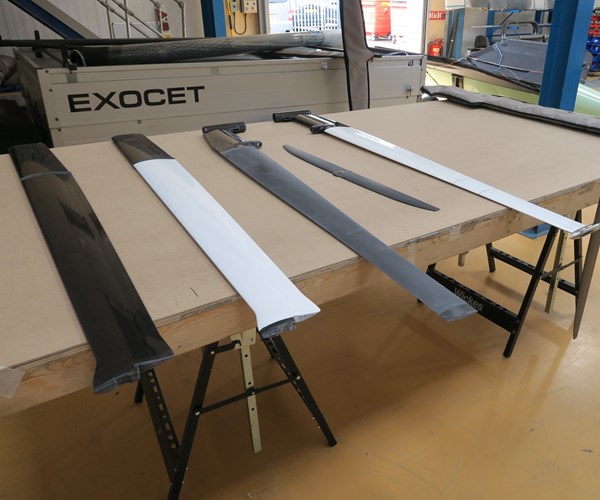This foiling racer is crazy fast thanks to composites
The Exocet racer’s hull and its foils, designed via computer model, are fabricated using hand layup and resin infusion methods, respectively, with PRO-SET epoxy.
I found in my inbox last week a picture like this one illustrating a blog by Jake Kavanagh (May 24, 2018) in the Epoxycraft newsletter —Epoxycraft is published by West System International (Romsey, UK), the maker of well-known marine epoxies WEST SYSTEM and PRO-SET under license from Gougeon Brothers Inc., now known as West System Inc. (Bay City, MI, US). The blog described the Exocet racer (Moth class) built by Maguire Boats (New Milton, Hampshire, UK) and it spurred me to do some research on how it is possible to do what the guy in the picture is doing.
First, what is a Moth? It refers to a class of small single-handed dinghys that first appeared in Australia in the late 1920s and in the US in 1930. The name “Moth” was coined by the American group, and Moth Class racing began later in the 1930s. An International Moth Class boat is 3.4m in length with unrestricted hull weight. So why is this small boat 6 feet above the surface of the water? It is, of course, supported by foils, or small wing-shaped structures at the ends of long tubular supports that attach to the hull. The foils create lift as the boat speed increases and lift the hull out of the water; the wetted area of the craft is radically reduced and boat speed is significantly increased.
Moths have been foiling since the 1970s, according to the International Moth Class Assn. UK web site — and did you know that foils were first invented by Alexander Graham Bell, working with Italian inventor Enrico Forlanini in the early 1900s? (Epoxycraft’s September 30, 2016 blog explains the history of foil development). In fact, according to some sources, the fast speeds achieved by foiling Moths was the inspiration for the most recent America’s Cup Class hydrofoiling yachts.
So the concept is more than 100 years old, but the technology for achieving 30 knots (55 km/hour) as described in Kavanagh’s blog is exemplified by Maguire Boats. The company, says the blog, has worked closely with designer Kevin Ellway for over five years since the introduction of the Exocet. This close partnership has enabled Maguire to continually improve a boat that has won the last three Moth World Championships as well as multiple European and National titles, including the 17 top positions at the Moth Worlds in Bermuda, earlier this year.

Foils for the Exocet are made in an infusion process using PRO-SET epoxy and ultra high modulus carbon cloth.
Kavanagh’s blog says that the Exocet hull and its foils, designed via computer model, are fabricated using hand layup and resin infusion methods, respectively, with PRO-SET epoxy. Maguire Boats’ managing director Simon Maguire says that his team first visited West System’s research lab to learn about effective infusion processes, ones that have resulted in parts with very high strength-to-weight ratio. For example, the hull components are a sandwich of ultra-high modulus (UHM) carbon fiber skins over a very thin foam core. With PRO-SET LAM 125 epoxy resin with LAM 226 hardener, the resulting hull section weighs just 10kg, says Maguire. The foils are infused in solid aluminum molds using PRO-SET infusion epoxy INF 114/210/211 with UHM carbon cloth, says the blog.
Maguire’s production rate is 24 boats a year, built in batches of four, according to Kavanagh’s blog. Maguire says “If we start making more than that, there is a risk to the quality. We pride ourselves on the consistency of the finish and performance of each boat, which makes them so sought after. Quality is everything – and as the results show, it wins races.” Read the entire Kavanagh blog here: https://www.epoxycraft.com/pro-set-laminated-maguire-exocets-top-moth-world-championships/ and learn more about the history of foiling watercraft here: https://www.epoxycraft.com/why-hydrofoiling-is-taking-the-sailing-world-by-storm/.
Related Content
JEC World 2022, Part 3: Emphasizing emerging markets, thermoplastics and carbon fiber
CW editor-in-chief Jeff Sloan identifies companies exhibiting at JEC World 2022 that are advancing both materials and technologies for the growing AAM, hydrogen, automotive and sustainability markets.
Read MoreCycling forward with bike frame materials and processes
Fine-tuning of conventional materials and processes characterizes today’s CFRP bicycle frame manufacturing, whether in the large factories of Asia or at reshored facilities in North America and Europe. Thermoplastic resins and automated processes are on the horizon, though likely years away from high-volume production levels.
Read MoreMaterials & Processes: Resin matrices for composites
The matrix binds the fiber reinforcement, gives the composite component its shape and determines its surface quality. A composite matrix may be a polymer, ceramic, metal or carbon. Here’s a guide to selection.
Read MorePlant tour: National Institute for Aviation Research, Wichita, Kan., U.S.
NIAR, located at Wichita State University in the heart of the American aerospace manufacturing industry, has evolved to become a premier hub of teaching, R&D, creativity and innovation.
Read MoreRead Next
CW’s 2024 Top Shops survey offers new approach to benchmarking
Respondents that complete the survey by April 30, 2024, have the chance to be recognized as an honoree.
Read MoreComposites end markets: Energy (2024)
Composites are used widely in oil/gas, wind and other renewable energy applications. Despite market challenges, growth potential and innovation for composites continue.
Read MoreFrom the CW Archives: The tale of the thermoplastic cryotank
In 2006, guest columnist Bob Hartunian related the story of his efforts two decades prior, while at McDonnell Douglas, to develop a thermoplastic composite crytank for hydrogen storage. He learned a lot of lessons.
Read More


























